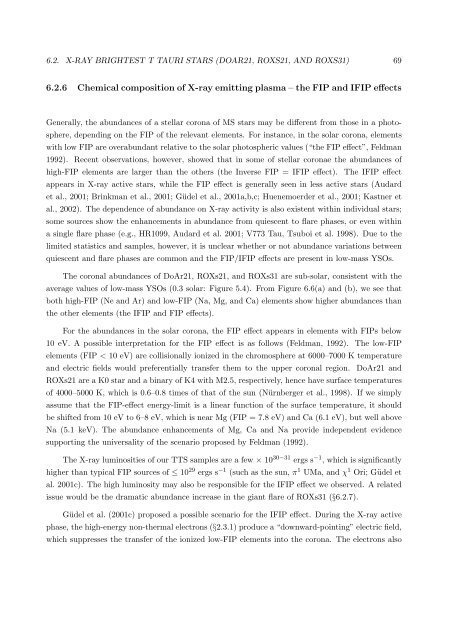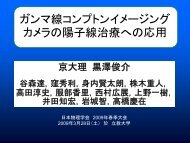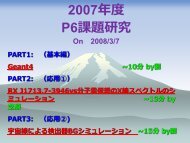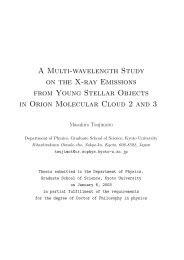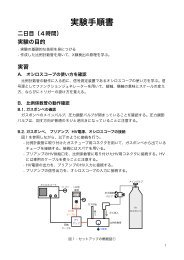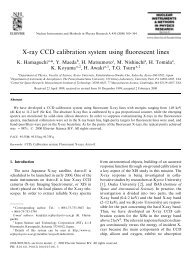X-ray Study of Low-mass Young Stellar Objects in the ρ Ophiuchi ...
X-ray Study of Low-mass Young Stellar Objects in the ρ Ophiuchi ...
X-ray Study of Low-mass Young Stellar Objects in the ρ Ophiuchi ...
You also want an ePaper? Increase the reach of your titles
YUMPU automatically turns print PDFs into web optimized ePapers that Google loves.
6.2. X-RAY BRIGHTEST T TAURI STARS (DOAR21, ROXS21, AND ROXS31) 696.2.6 Chemical composition <strong>of</strong> X-<strong>ray</strong> emitt<strong>in</strong>g plasma – <strong>the</strong> FIP and IFIP effectsGenerally, <strong>the</strong> abundances <strong>of</strong> a stellar corona <strong>of</strong> MS stars may be different from those <strong>in</strong> a photosphere,depend<strong>in</strong>g on <strong>the</strong> FIP <strong>of</strong> <strong>the</strong> relevant elements. For <strong>in</strong>stance, <strong>in</strong> <strong>the</strong> solar corona, elementswith low FIP are overabundant relative to <strong>the</strong> solar photospheric values (“<strong>the</strong> FIP effect”, Feldman1992). Recent observations, however, showed that <strong>in</strong> some <strong>of</strong> stellar coronae <strong>the</strong> abundances <strong>of</strong>high-FIP elements are larger than <strong>the</strong> o<strong>the</strong>rs (<strong>the</strong> Inverse FIP = IFIP effect). The IFIP effectappears <strong>in</strong> X-<strong>ray</strong> active stars, while <strong>the</strong> FIP effect is generally seen <strong>in</strong> less active stars (Audardet al., 2001; Br<strong>in</strong>kman et al., 2001; Güdel et al., 2001a,b,c; Huenemoerder et al., 2001; Kastner etal., 2002). The dependence <strong>of</strong> abundance on X-<strong>ray</strong> activity is also existent with<strong>in</strong> <strong>in</strong>dividual stars;some sources show <strong>the</strong> enhancements <strong>in</strong> abundance from quiescent to flare phases, or even with<strong>in</strong>a s<strong>in</strong>gle flare phase (e.g., HR1099, Audard et al. 2001; V773 Tau, Tsuboi et al. 1998). Due to <strong>the</strong>limited statistics and samples, however, it is unclear whe<strong>the</strong>r or not abundance variations betweenquiescent and flare phases are common and <strong>the</strong> FIP/IFIP effects are present <strong>in</strong> low-<strong>mass</strong> YSOs.The coronal abundances <strong>of</strong> DoAr21, ROXs21, and ROXs31 are sub-solar, consistent with <strong>the</strong>average values <strong>of</strong> low-<strong>mass</strong> YSOs (0.3 solar: Figure 5.4). From Figure 6.6(a) and (b), we see thatboth high-FIP (Ne and Ar) and low-FIP (Na, Mg, and Ca) elements show higher abundances than<strong>the</strong> o<strong>the</strong>r elements (<strong>the</strong> IFIP and FIP effects).For <strong>the</strong> abundances <strong>in</strong> <strong>the</strong> solar corona, <strong>the</strong> FIP effect appears <strong>in</strong> elements with FIPs below10 eV. A possible <strong>in</strong>terpretation for <strong>the</strong> FIP effect is as follows (Feldman, 1992). The low-FIPelements (FIP < 10 eV) are collisionally ionized <strong>in</strong> <strong>the</strong> chromosphere at 6000–7000 K temperatureand electric fields would preferentially transfer <strong>the</strong>m to <strong>the</strong> upper coronal region. DoAr21 andROXs21 are a K0 star and a b<strong>in</strong>ary <strong>of</strong> K4 with M2.5, respectively, hence have surface temperatures<strong>of</strong> 4000–5000 K, which is 0.6–0.8 times <strong>of</strong> that <strong>of</strong> <strong>the</strong> sun (Nürnberger et al., 1998). If we simplyassume that <strong>the</strong> FIP-effect energy-limit is a l<strong>in</strong>ear function <strong>of</strong> <strong>the</strong> surface temperature, it shouldbe shifted from 10 eV to 6–8 eV, which is near Mg (FIP = 7.8 eV) and Ca (6.1 eV), but well aboveNa (5.1 keV). The abundance enhancements <strong>of</strong> Mg, Ca and Na provide <strong>in</strong>dependent evidencesupport<strong>in</strong>g <strong>the</strong> universality <strong>of</strong> <strong>the</strong> scenario proposed by Feldman (1992).The X-<strong>ray</strong> lum<strong>in</strong>osities <strong>of</strong> our TTS samples are a few × 10 30−31 ergs s −1 , which is significantlyhigher than typical FIP sources <strong>of</strong> ≤ 10 29 ergs s −1 (such as <strong>the</strong> sun, π 1 UMa, and χ 1 Ori; Güdel etal. 2001c). The high lum<strong>in</strong>osity may also be responsible for <strong>the</strong> IFIP effect we observed. A relatedissue would be <strong>the</strong> dramatic abundance <strong>in</strong>crease <strong>in</strong> <strong>the</strong> giant flare <strong>of</strong> ROXs31 (§6.2.7).Güdel et al. (2001c) proposed a possible scenario for <strong>the</strong> IFIP effect. Dur<strong>in</strong>g <strong>the</strong> X-<strong>ray</strong> activephase, <strong>the</strong> high-energy non-<strong>the</strong>rmal electrons (§2.3.1) produce a “downward-po<strong>in</strong>t<strong>in</strong>g” electric field,which suppresses <strong>the</strong> transfer <strong>of</strong> <strong>the</strong> ionized low-FIP elements <strong>in</strong>to <strong>the</strong> corona. The electrons also


